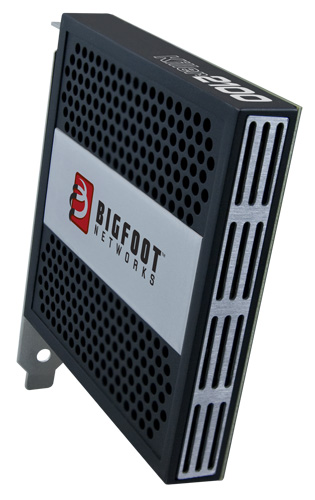
- #BIGFOOT NETWORKS KILLER ETHERNET CONTROLLER DRIVER FOR FREE#
- #BIGFOOT NETWORKS KILLER ETHERNET CONTROLLER DRIVER DRIVER#
- #BIGFOOT NETWORKS KILLER ETHERNET CONTROLLER DRIVER SERIES#
- #BIGFOOT NETWORKS KILLER ETHERNET CONTROLLER DRIVER WINDOWS#
Using hardware to bypass the operating system’s network stack reverted to the realm of high-frequency traders.
#BIGFOOT NETWORKS KILLER ETHERNET CONTROLLER DRIVER DRIVER#
At this point, Bigfoot began turning the Killer technology into an intelligent software layer focused on traffic classification and prioritization, built on top of a network driver tweaked for low latency. Suddenly, the performance of the dedicated hardware solution could be matched by moving Killer’s network processing to the host CPU. The pivotal moment in the life of Killer’s tech, I’m told, came about with the release of Intel’s Nehalem-based Core i7 processors in 2008. That solution never led to the mass-market adoption for which Bigfoot was hoping. In the end, the dedicated hardware of the Killer NIC simply cost more than the onboard GigE solutions that relied on the standard combination of a controller and a PHY.
#BIGFOOT NETWORKS KILLER ETHERNET CONTROLLER DRIVER FOR FREE#
Subsequent iterations of Killer hardware brought the price down to a more palatable $79, but Killer was still asking buyers to fork over money for a component most folks were used to getting for free on their motherboards. Part of the problem may have been the card’s price tag-$279, to be exact. While a handful of interesting apps were produced, no killer app emerged. Bigfoot even offered a software developer’s kit that allowed end users to write their own applications for the Killer NIC.
#BIGFOOT NETWORKS KILLER ETHERNET CONTROLLER DRIVER WINDOWS#
This hardware could operate in a mode that bypassed the Windows networking stack entirely to purportedly speed up packet processing and reduce latency. The cards ran a custom embedded Linux distribution. Early Killer cards had dedicated network hardware built around a Freescale PowerPC system-on-a-chip with 64MB of dedicated memory.
#BIGFOOT NETWORKS KILLER ETHERNET CONTROLLER DRIVER SERIES#
Bigfoot wanted to bring innovation to consumer networking with a series of gaming-focused NICs. Bigfoot Networks-the company that created the Killer NIC-arrived on the scene in 2006. But before we get to that, I’ll discuss what I learned from my visit.įor those not familiar with the Killer story, here’s the Cliff’s Notes version. With its twin GigE interfaces-one Killer-powered and one Intel-powered-it’s the perfect candidate for some side-by-side testing. Our test subject in this case is the Z170X-Gaming 7. The company also gave me a demo of the Killer traffic-prioritization technology, as well as a look at DoubleShot Pro-a solution in which Killer’s wired and wireless controllers work together to shuttle low-priority traffic over Wi-Fi and high-priority packets over Ethernet.Īs TR’s motherboard guy, I came away from the visit eager to do some in-depth testing of the Killer E2400 Gigabit Ethernet controller that we’ve seen on the last two Z170 boards we reviewed: the Gigabyte Z170X-Gaming 7 and the MSI Z170A Gaming M5. I spent my time at Rivet Networks asking lots of questions about the hardware and software that makes up Killer’s current products, the team’s success in getting motherboard and laptop design wins, and how the Killer products have changed since the days of the original Killer NIC. As of this month, though, he’s made his way back to the Killer team to help with marketing and business development. In late 2007, he left Bigfoot for AMD, where he ran a number of marketing and sales teams. He served as the company’s vice-president of marketing and sales. Like Cubbage, Grim is one of the founders of Bigfoot Networks.

He’s also responsible for taking Killer independent again with Rivet Networks. Cubbage is one of the co-founders of Bigfoot Networks, and he’s been with the Killer Networking team from the beginning, through Qualcomm’s purchase of Bigfoot in 2011 and during the team’s time as part of the Big Q.

While I was there, I got a chance to pick the brains of Killer CEO Mike Cubbage and Chief Marketing Officer Bob Grim.

Now that a good number of gaming-focused Z170-based boards and laptops include Gigabit Ethernet (and wireless networking) powered by Killer, it’s the perfect time to do some fresh testing.Ī few weeks ago, I visited the Killer Networking folks at Rivet Networks. It’s been just over eight years since we first took an in-depth look at a Killer NIC. The folks behind the Killer Networking products first burst on to the scene trying to change that, and they’re still at it. We’ve had it for a long time, and for the most part, it just works. Onboard Gigabit Ethernet: we don’t think about it too much.


 0 kommentar(er)
0 kommentar(er)
